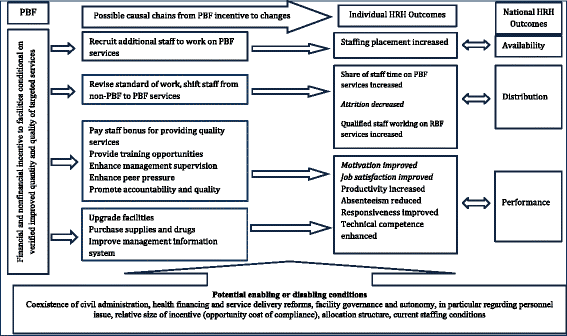Incentives to change: effects of performance-based financing on health workers in Zambia
- PMID: 28245877
- PMCID: PMC5331731
- DOI: 10.1186/s12960-017-0179-2
Incentives to change: effects of performance-based financing on health workers in Zambia
Abstract
Background: Performance-based financing (PBF) has been implemented in a number of countries with the aim of transforming health systems and improving maternal and child health. This paper examines the effect of PBF on health workers' job satisfaction, motivation, and attrition in Zambia. It uses a randomized intervention/control design to evaluate before-after changes for three groups: intervention (PBF) group, control 1 (C1; enhanced financing) group, and control 2 (C2; pure control) group.
Methods: Mixed methods are employed. The quantitative portion comprises of a baseline and an endline survey. The survey and sampling scheme were designed to allow for a rigorous impact evaluation of PBF or C1 on several key performance indicators. The qualitative portion seeks to explain the pathways underlying the observed differences through interviews conducted at the beginning and at the three-year mark of the PBF program.
Results: Econometric analysis shows that PBF led to increased job satisfaction and decreased attrition on a subset of measures, with little effect on motivation. The C1 group also experienced some positive effects on job satisfaction. The null results of the quantitative assessment of motivation cohere with those of the qualitative assessment, which revealed that workers remain motivated by their dedication to the profession and to provide health care to the community rather than by financial incentives. The qualitative evidence also provides two explanations for higher overall job satisfaction in the C1 than in the PBF group: better working conditions and more effective supervision from the District Medical Office. The PBF group had higher satisfaction with compensation than both control groups because they have higher compensation and financial autonomy, which was intended to be part of the PBF intervention. While PBF could not address all the reasons for attrition, it did lower turnover because those health centers were staffed with qualified personnel and the personnel had role clarity.
Conclusions: In Zambia, the implementation of PBF schemes brought about a significant increase in job satisfaction and a decrease in attrition, but had no significant effect on motivation. Enhanced health financing also increased stated job satisfaction.
Keywords: Health system strengthening; Human resources for health; Mixed methods; Organizational behavior; Pay-for-performance; Performance-based financing; Zambia.
Figures
References
-
- Zambia Ministry of Health . National Health Strategic Plan 2011-2015. Zambia Ministry of Health: Lusaka; 2011.
-
- Bangdiwala SI, Fonn S, Okoye O, Tollman S. Workforce resources for health in developing countries. Public Health Rev. 2010;32(1):296–318.
-
- World Health Organization . The World Health Report 2006: Working Together for Health. Geneva, Switzerland: World Health Organization; 2006. - PubMed
-
- World Health Organization. African Health Observatory . Human resources for health country profile: Zambia. Geneva: World Health Organization; 2010.
-
- Zambia Ministry of Health . National Human Resources for Health Strategic Plan 2011-2015. Zambia Ministry of Health: Lusaka; 2011.
Publication types
MeSH terms
LinkOut - more resources
Full Text Sources
Other Literature Sources
Miscellaneous



